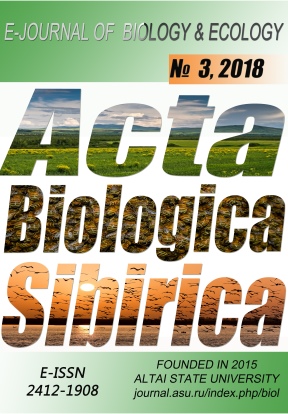Abstract
Complex algological and hydrochemical studies were performed in July 2017 at the mouths of Upper Angara and Kichera rivers, as well as three mouths of Angara-Kichera estuary — Dushkachanskoye, Srednee and Dagarskoye, which supply water to Lake Baikal. The species diversity of scaled chrysophytes was studied via scanning and transmission electron microscopy. A total of 31 species and intraspecific taxa were detected: Chrysosphaerella — 1; Paraphysomonas — 2; Spiniferomonas — 8; Mallomonas — 14; Synura — 6. As a result, the list of scaled chrysophyte species in the Baikal region was extended by 3 taxa and currently includes 76 species and intraspecific taxa, thus making its diversity of scaled chrysophytes the highest in the world.
References
Atlas and Key of Baikal Pelagic bionts (with brief profiles of their ecology) (1995). In: Timoshkin, O.A., Mazepova, G.F., Melnik, N.G. et al. (Eds). Novosibirsk: Nauka (in Russian).
Balonov, I.M. (1976). Biology, morphology and taxonomy of aquatic organisms. Proceeding of IBIW AS USSR, 31(34), 174 (in Russian).
Baram, G.I., Vereshchagin, A.L., Golobokova, L.P. (1999). Application of Microcolumn HPLC with UV Detection to Analysis of Anions in Environmental Objects. Zhurnal Analiticheskoi Khimii, 54, 962–965 (in Russian).
Bessudova, A.Yu., Firsova, A.D., Sorokovikova, L.M., Tomberg, I.V. (2016). Silica-scaled chrysophytes of the Lower Yenisei basin and bays of the Kara Sea with autecology elements. Irkutsk: Institute of Geografy (in Russian).
Bessudova, A., Tomberg, V., Firsova, A.D., Kopyrina, L.I., Likhoshway, Ye.V. (2016). Silica-scaled chrysophytes in lakes Labynkyr and Vorota, Yakutia, Russia. 9th International Chrysophyte Symposium (ICS9), Japan, Yamagata.
Bessubova, A.Yu., Likhoshway, Ye.V. (2017). Silica chrysophytes (Chrysophyceae) of the Boguchany reservoir. Modern science: actual problems of theory and practice. Series "Natural and technical sciences (General biology), 11, 4–11 (in Russian). URL: http://www.nauteh-journal.ru/index.php/----etn17-11/3936-a
Bessudova, A.Yu., Domysheva, V.M., Firsova, A.D., Likhoshway, Y.V. (2017). Silica-scaled chrysophytes of Lake Baikal. Acta Biologica Sibirica, 3(3), 47–56. DOI: http://dx.doi.org/10.14258/abs.v3i3.3615
Bessudova, A.Yu., Sorokovikova, L.M., Tomberg, I.V., Likhoshway, E.V. (2018). Silica-scaled chrysophytes in large tributaries of Lake Baikal. Cryptogamie, Algologie, 39(2), 145–165. DOI:10.7872/crya/v39.iss2.2018.145
Bessudova, A., Bukin, Y.S., Sorokovikova, L.M., Firsova, A.D., Tomberg, I.V. (2018). Silica-scaled chrysophytes in small lakes of the lower Yenisei basin, the arctic. Nova Hedwigia. DOI: https://doi.org/10.1127/nova_hedwigia/2018/0473
Bogdanov, V.T. (1978). Formation of the hydrochemical regime of the Northern Baikal. Novosibirsk: Nauka (in Russian).
Hällfors, G., Hällfors, S. (1988). Records of chrysophytes with siliceous scales (Mallomonadaceae and Paraphysomonadaceae) from Finnish inland waters. Flagellates in freshwater ecosystems. Hydrobiologia, 161, 1–29. DOI: 10.1007/978-94-009-3097-1_1
Gusev, E.S. (2016). Contribution to the flora of silica-scaled chrysophytes of Frolikha Lake (North transbaikal area). Proceeding of IBIW RAS, 76(79), 25–30 (in Russian).
Gusev, E.S. (2013). Silica-scaled chrysophytes from low-mineralized karst lakes in Central Russia. Nova Hedwigia, Beihefte, 142, 17–25.
Kuzmin, G.V. (1975). Phytoplankton. Species composition and abundance. methods for studying biogenocenoses of inland waters. Moscow: Nauka (in Russian).
Matvienko, A.M. (1954). Zolotistye vodorosli. Opredelitel’ presnovodnykh vodoroslei SSSR (Chrysophyte Algae: Identification Key to Freshwater Algae of the Soviet Union). Moscow: Sovetskaya Nauka, 188 p. (in Russian).
Němcová, Y., Kreidlová, J., Kosova, A., Neustupa, J. (2012). Lakes and pools of Aquitania region (France) – a biodiversity hotspot of Synurales in Europe. Nova Hedwigia, 95, 1–24. DOI: 10.1127/0029-5035/2012/0036
Manual for chemical analysis of inland surface waters. (2009). Part 1. Rostov-on-Don: NOK, 1045 p. (in Russian).
Oksinuk, O.P., Zhukinsky, V.N., Braginsky, L.P., Linnik, P.N., Kuzmenko, M.I., Klenus, V.G. (1993). Integrated ecological classification of inland surface waters. Hydrobiological Journal, 4, 62–76 (in Russian).
Scoble, J.M., Cavalier-Smith, T. (2014). Scale evolution in Paraphysomonadida (Chrysophyceae): Sequence phylogeny and revised taxonomy of Paraphysomonas, new genus Clathromonas, and 25 new species. European Journal of Protistology, 50, 551–592. DOI: 10.1016/j.ejop.2014.08.001
Siver, P.A., Voloshko, L.N., Gavrilova, O.V., Getsen, M.V. (2005). The scaled chrysophyte flora of the Bolshezemelskaya tundra. Nova Hedwigia Beiheft, 128, 125–150.
Sorokovikova, L.M., Tomberg, I.V., Bashenkhaeva, N.V. (2008). The chemical composition of Selenga river waters and its Delta / Delta of the Selenga River as a biofilterand indicator of the state of Lake Baikal. Novosibirsk: Nauka (in Russian).
Sorokovikova, L.M., Popovskaya, G.I., Tomberg, I.V., Bashenkhaeva, N.V. (2009). Spatial and temporal variability of nutrient and organic matter concentrations and phytoplankton in the water of the Selenga River and channels of its delta. Water resources, 36(4), 465–474 (in Russian).
Sorokovikova, L.M., Sinyukovich, V.N., Tomberg, I.V., Marinaite, I.I.,
Khodzher, T.V. (2015). Assessment of water quality of Lake Baikal tributaries from chemical parameters. Geography and natural resources, 36 (1), 37–45 (in Russian).
Starmach, K. (1985). Chrysophyceae and Haptophyceae. Jena: Gustav Fischer, Verlag.
Votintsev, K.K., Glazunov, I.V., Tolmacheva, A.P. (1965). Hydrochemistry of rivers of Lake Baikal basin. Moscow: Nauka (in Russian).
Wetzel, R.G., Likens, G.E. (2003). Limnological Analyses. N.Y.: Springer-Verlag.

This work is licensed under a Creative Commons Attribution 4.0 International License.

